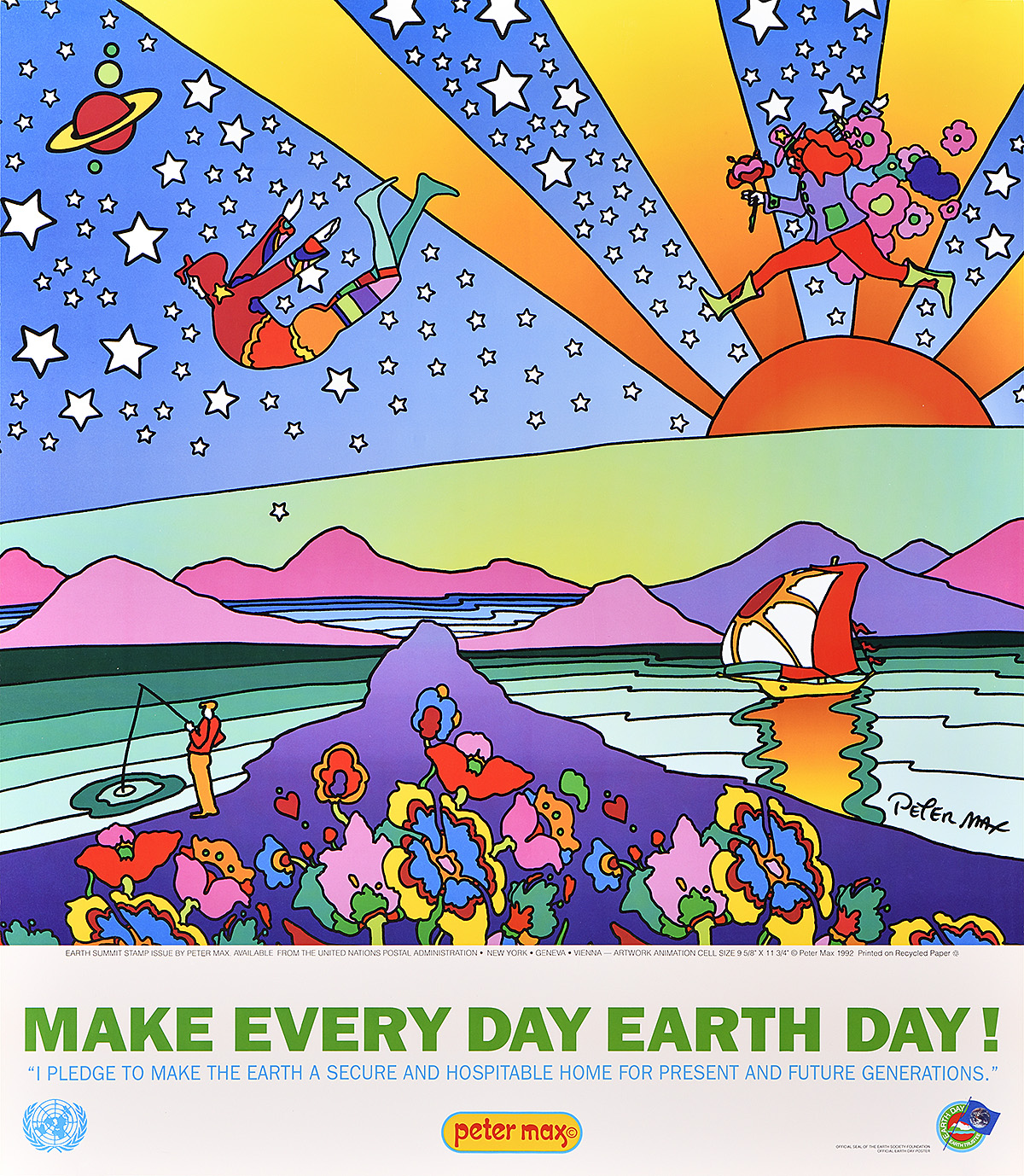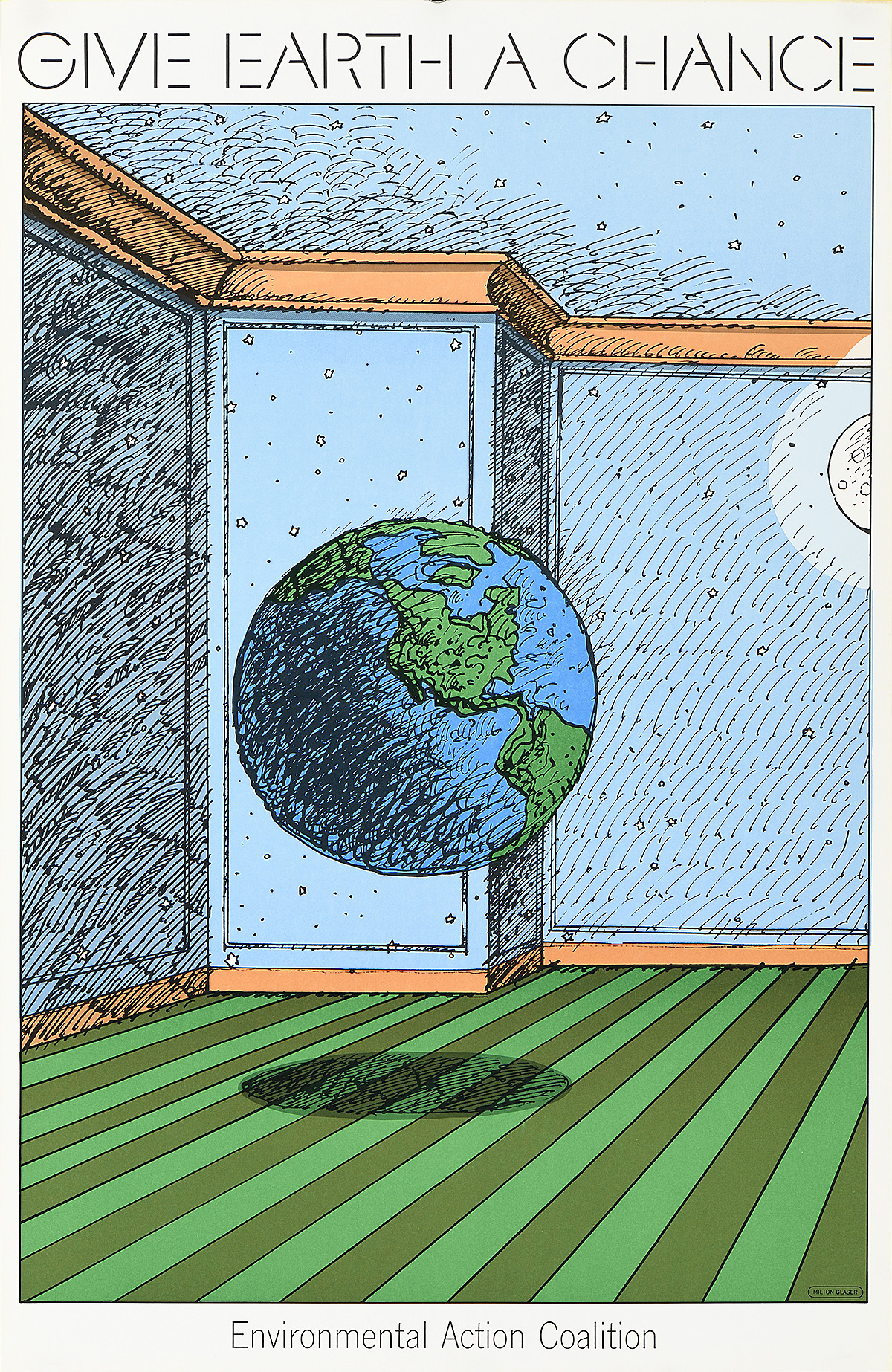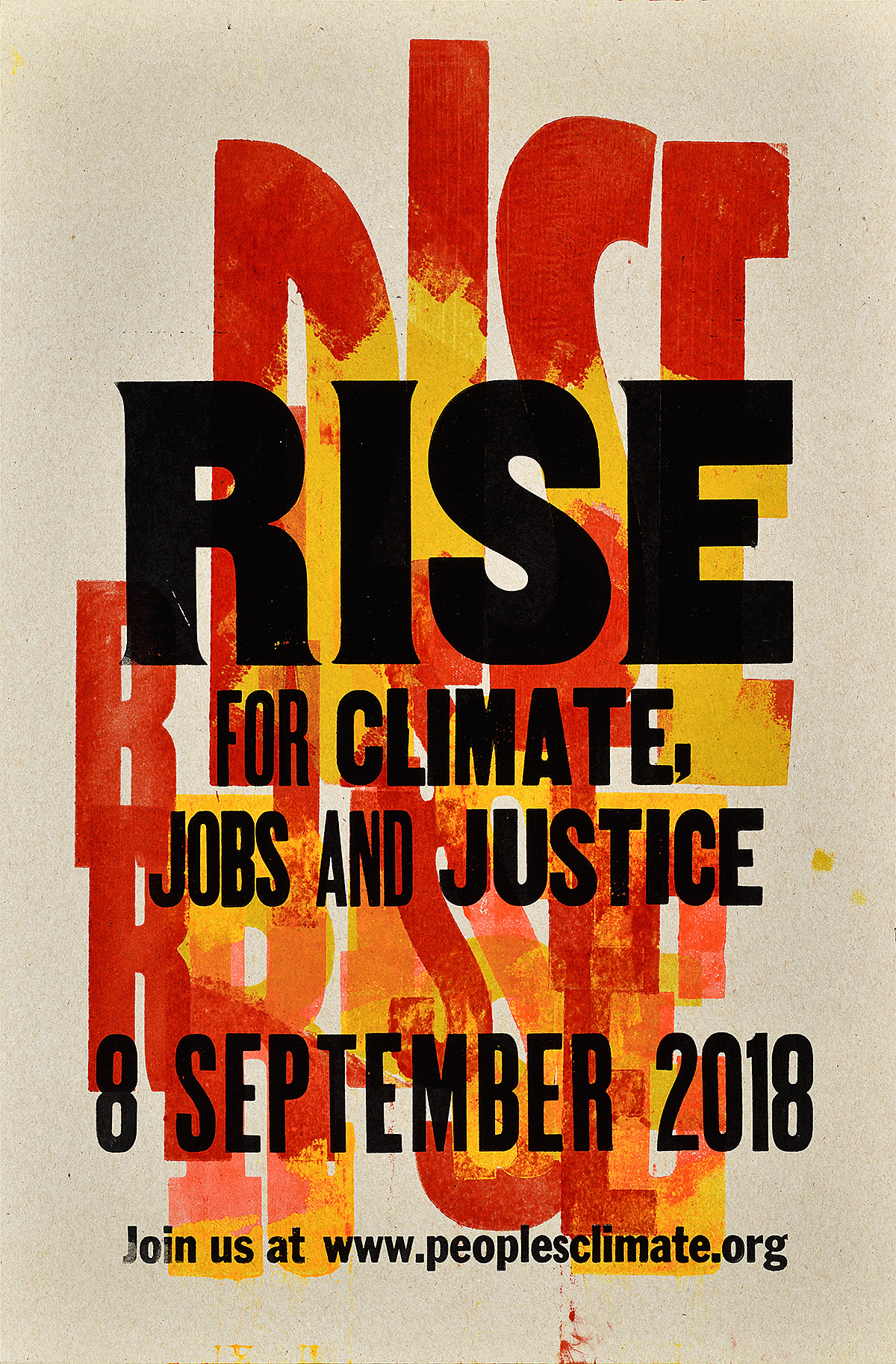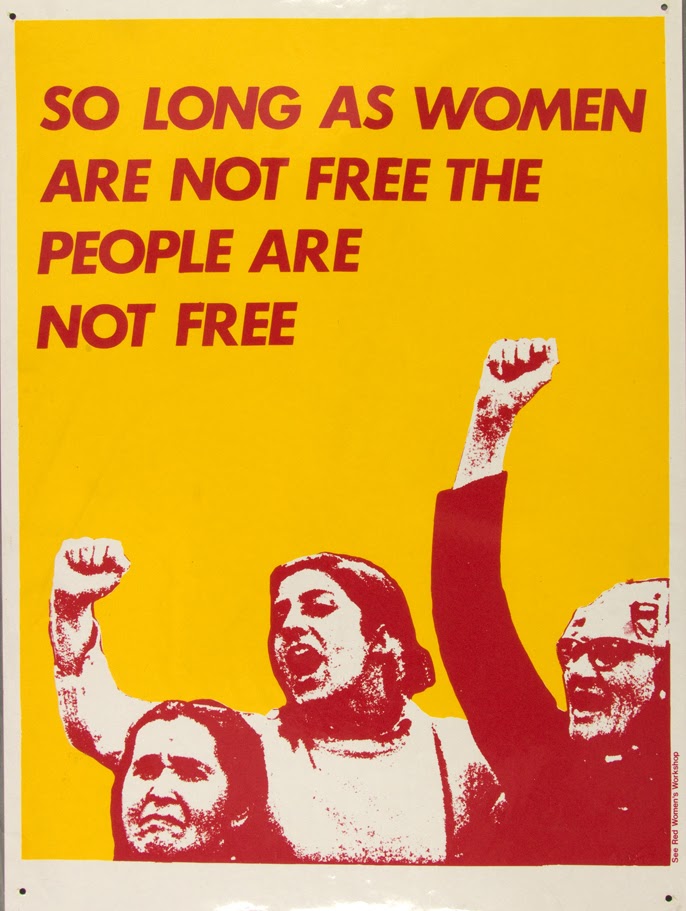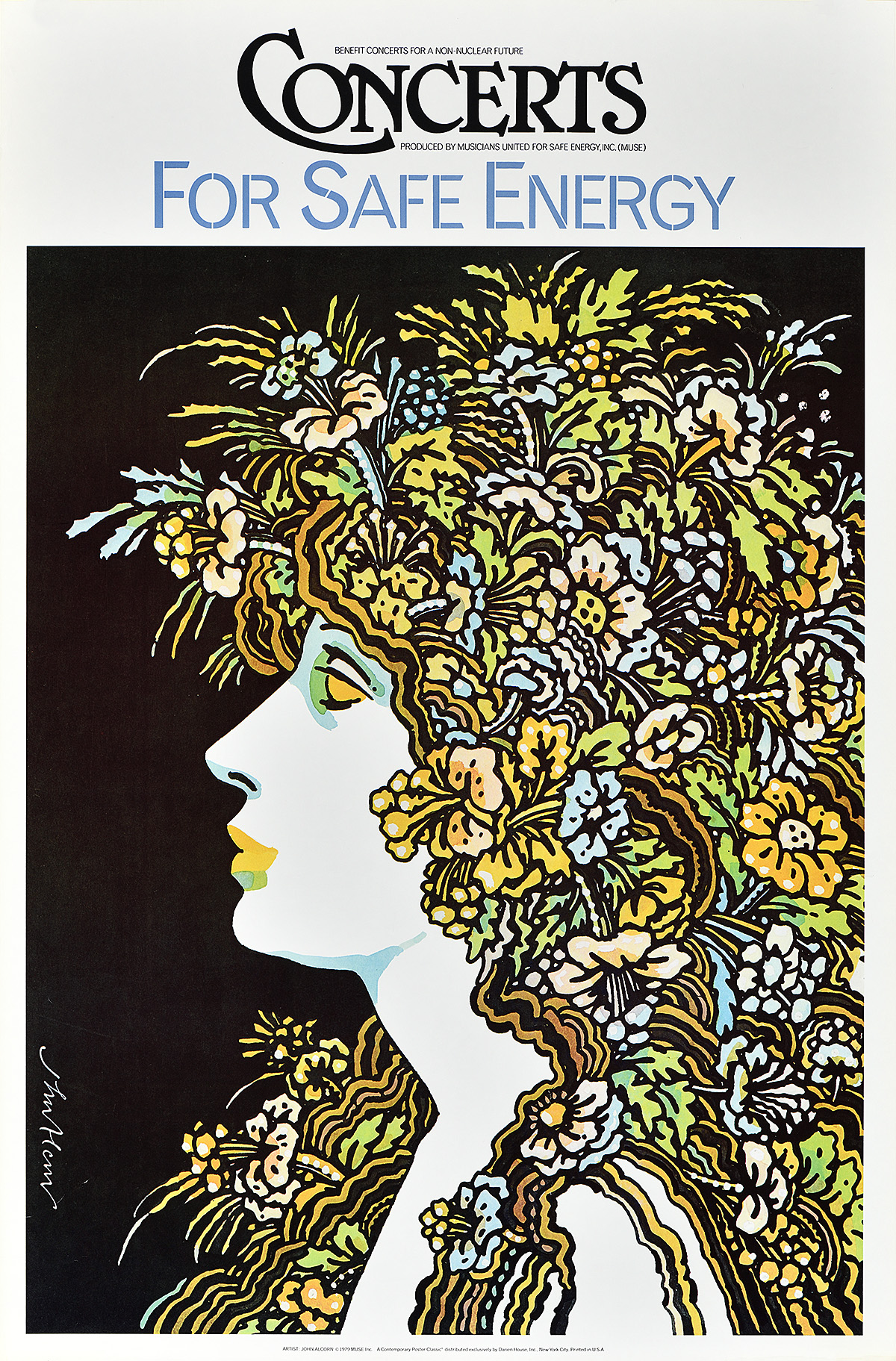
Songs for the Anti-Nuclear Movement
.There is typically a delay of at least a few weeks between the writing of the museum’s blogs and their posting on the website. But this one is unusually timely. As I write this from the U.K. on a very hot weekend, the Glastonbury Festival is live on TV; it’s an event that has considerable relevance to Poster House’s current show, Fallout: Atoms for War & Peace (on view through September 7).
Glastonbury is one of the largest music festivals in the world, currently attended by more than two hundred thousand people on a nine-hundred-acre site. The festival was launched in 1970, and from 1981 to 1990 was officially called the Glastonbury CND (Campaign for Nuclear Disarmament) Festival. Advance ticket sales were handled by CND, and the festival became the largest single funding source for the organization. Although this collaboration ended in 1990, the festival continues to focus on broad environmental and social-justice issues. The iconic Pyramid Stage, now in its third incarnation, still sports Gerald Holtom’s 1958 CND logo, better known globally as the peace symbol.

Sunday morning, Glastonbury 2025
Photo credit: Neil Medland
When I was cocurating Fallout: Atoms for War and Peace, I was reminded that those of us who were living in the U.K. and elsewhere during the late 1970s and 1980s were constantly aware of the very real threat of nuclear war. This is reflected not only in the posters in the exhibition but also in the music of the time.
The Glastonbury Festival has inspired me to create an antinuclear playlist to accompany Fallout as a sort of follow-up to the environmental playlist I put together for We Tried to Warn You! Environmental Crisis Posters that closed at Poster House in February 2024. Cause-based poster campaigns and music as manifestations of popular culture definitely appear to coalesce at certain points in history; in the case of fear of nuclear war, this coincidence happened in the 1980s.
There are probably those who feel that a playlist of songs dealing with the threat of nuclear war is either in bad taste or just plain depressing. I believe, however, that it is absolutely possible to have entertaining yet thoughtful songs about difficult subjects (and some of these songs even encourage dancing). Singers and songwriters have many of the same concerns as the rest of us and since their songs are the tools of their trade, it makes sense that they tend to vocalize their feelings. Also, as one of the musicians on TV just said, “music is medicine.”
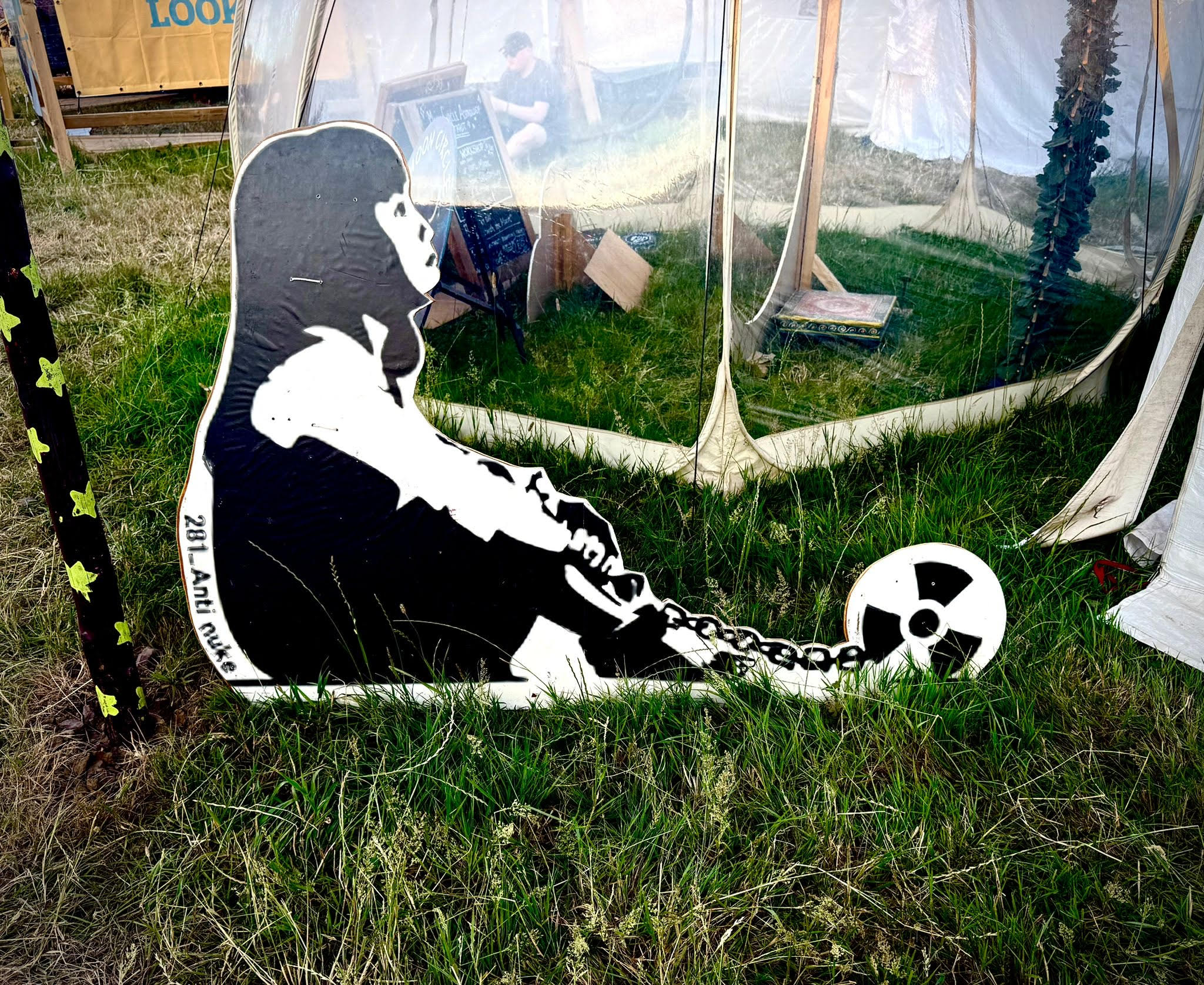
Installation by 281_Anti-Nuke, Glastonbury 2025
Photo credit: Neil Medland
Great antinuclear songs exist from before the 1980s, of course, and there are even a few from after that decade. The sheer number of songs from the eighties, however, has persuaded me to focus this by-no-means-exhaustive playlist on those particular tunes. As I listened to them, I was struck most immediately by how truly pervasive the fear of nuclear war was at that time. But I hope you enjoy the list and find in it some old treasures as well as discover at least a few songs that are new to you. I have some clear favorites and some of the songs are, frankly, not to my taste, but I wanted to provide a diverse grouping. As the strategic arms limitation agreements came into place in the 1990s, fewer songs like these were written and performed, a situation that we can only hope persists.
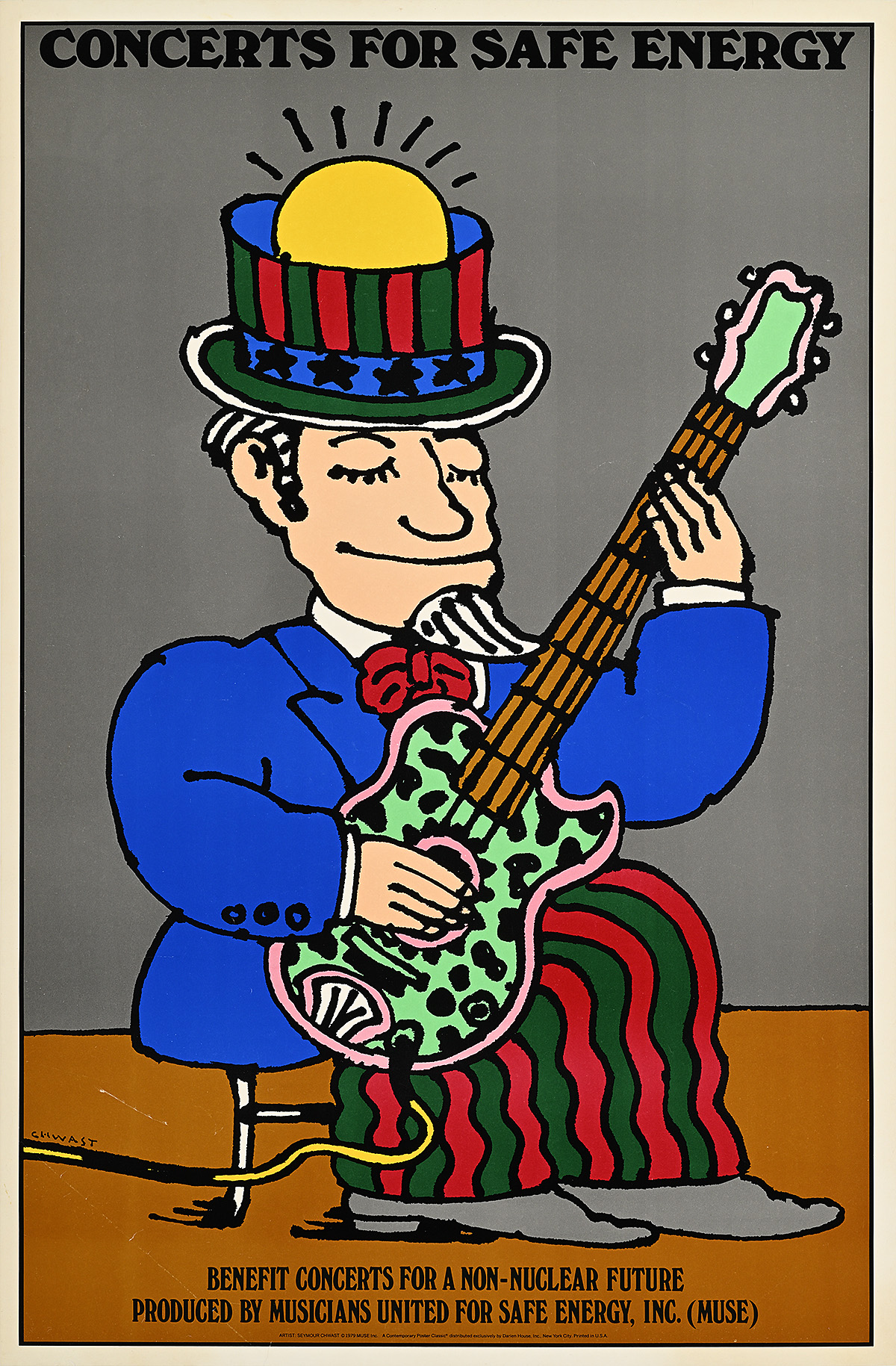
Concerts for Safe Energy (1979), Seymour Chwast
Poster House Permanent Collection
Enola Gay (1980) by Orchestral Manoeuvres in the Dark. The title of the song is taken from that of the first aircraft to drop an atomic bomb in warfare, the Boeing B29 that targeted Hiroshima in August 1945. The song became a dance-floor hit but was banned by some radio stations whose management thought it was promoting homosexuality!
London Calling (1980) by The Clash. “I was talking to my girlfriend, there was a lot of cold war nonsense going on, and we knew that London was susceptible to flooding,” said the band’s lead vocalist Joe Strummer. The song also seems to have been influenced by the partial meltdown of the Three Mile Island nuclear plant the previous year. Not strictly an anti-nuclear war song but it fits here I think.
Seven Minutes to Midnight (1980) by Wah! Heat. The title of the song refers to the fact that in this year, the Bulletin of Atomic Scientists moved the dial of its notorious Doomsday Clock forward by two minutes to the eponymous seven minutes to midnight due to increasing fears about nuclear conflict. For reference, in January 2025, the clock’s dial was moved to a new low of 89 seconds to midnight.
Breathing (1980) by Kate Bush. “We’ve lost our chance, we’re the first and the last, after the blast, chips of plutonium are twinkling in every lung.” This is a song told from the perspective of a foetus who is aware of what is going on outside the womb.
Do you Believe in the Westworld? (1981) by Theatre of Hate. Cowboys versus Bears, and mutually assured destruction set to a Spaghetti-Western-style soundtrack.
1999 (1982) by Prince. A party jam urging us to enjoy life while we can, before the oncoming nuclear armageddon. Why 1999? Apparently Prince had read a little Nostradamus.
I Melt With You (1982) by Modern English. A couple making love as a thermonuclear device hits. “I’ll stop the world and melt with you.”
Why Did I Fall for That (1982) by The Who. The veteran rockers (even then) casting doubt on government propaganda suggesting that nuclear war was survivable for some.
Seconds (1983) by U2. The second song on U2’s magnificent War album. In the U.K., the album pushed Michael Jackson’s Thriller off the top of the charts, quite some achievement for an album that Bono feared would be too confrontational for listeners and “a slap in the face.”
99 Luftballons/ 99 Red Balloons (1983) by Nena. Originally released in German, the song describes a nuclear war precipitated by the confused reaction by a world on edge to 99 red balloons released by a few youths.
Two Suns in the Sunset (1983) by Pink Floyd. Mournful, you’ve been warned.
It’s a Mistake (1983) by Men at Work. The Australian band, better known for its cheerful song “Down Under,” in fear of a mistaken overreaction.
Distant Early Warning (1984) by Rush. The Canadian band with a song about the Distant Early Warning Line (DEW). DEW consisted of more than 60 manned radar stations in the Arctic designed to warn of incoming Soviet bombers.
Minutes to Midnight (1984) by Midnight Oil. Another Australian band whose songs frequently address social and political subjects.
Two Tribes (1984) by Frankie Goes to Hollywood. A chart phenomenon in the U.K., this was the longest-running number one single of the 1980s. A dance track about the end of the world, it featured snippets by Patrick Allen in which he recreated his narration of the infamous Protect and Survive public information campaign; this aimed to inform and protect the British public in the event of nuclear war but became something of a joke, as evidenced by this marvelous CND poster by Peter Kennard.
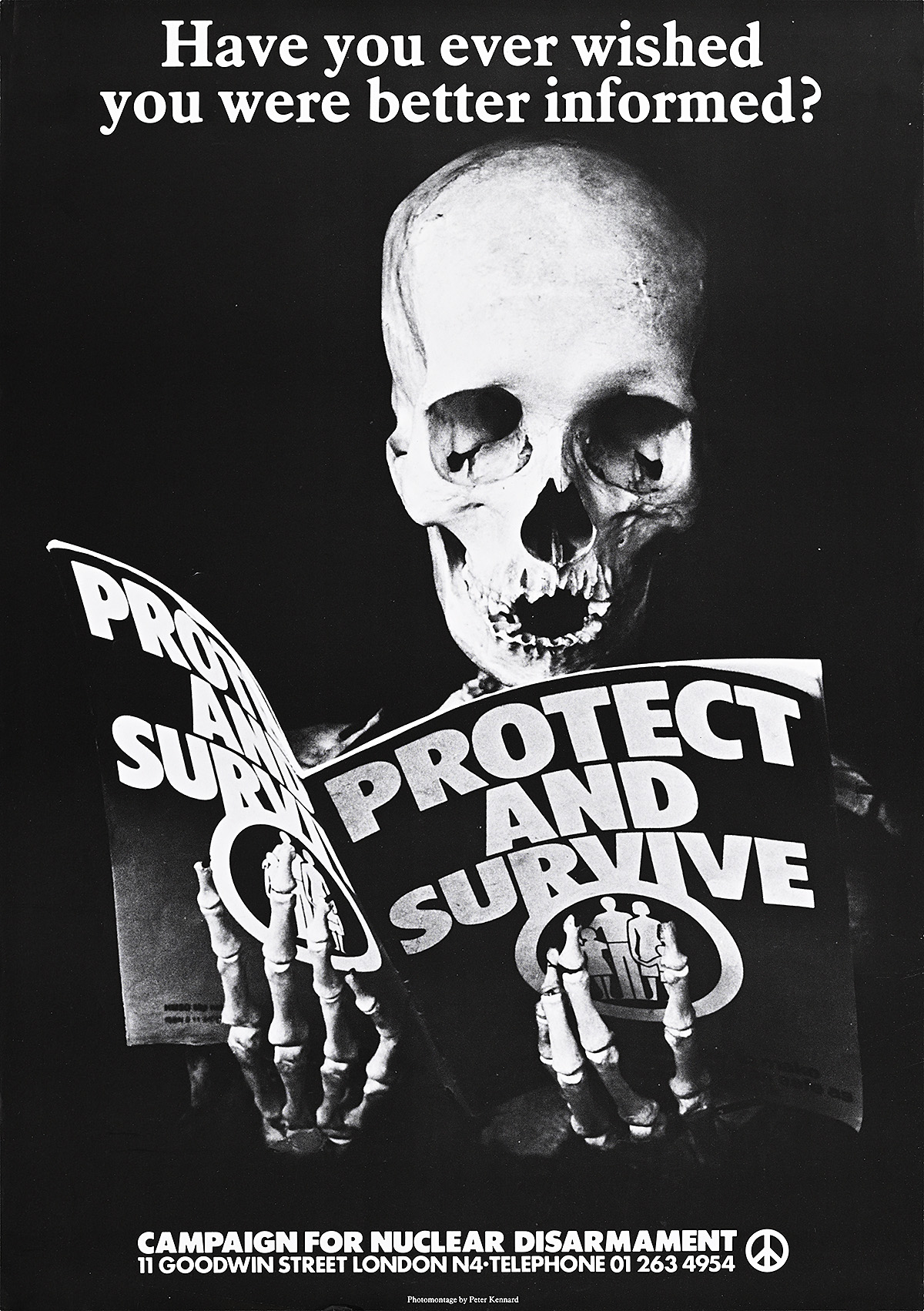
Protect and Survive (1980), Peter Kennard
Poster House Permanent Collection
Heaven (1984) by The Psychedelic Furs. “There’s a hole in the sky where the sun don’t shine, and a clock on the wall and it counts my time.” As Tim Butler, the band’s cofounder described the song, “It’s about planes ready to drop nuclear bombs, but people dance to it.”
Dancing with Tears in My Eyes (1984) by Ultravox. I remember watching them singing this at the Live Aid concert in Wembley Stadium in 1985. The band’s lead singer, Midge Ure, was one of the organizers of this event to raise funds for famine relief in Ethiopia.
2 Minutes to Midnight (1984) by Iron Maiden. Released on the 39th anniversary of the dropping of the first atomic bomb on August 6, 1945.
Party at Ground Zero (1985) by Fishbone. This one was new to me; it’s an L.A. band playing a ska/punk mix. The video was directed by Henry Selick, who would later find fame as the director of The Nightmare Before Christmas.
America (1985) by Kurtis Blow. This song is from the album of the same name and the one that gave Kurtis Blow the distinction of being hip-hop’s first commercially successful artist judged by becoming a millionaire.
Nuclear War (1985) by Jimmy Cliff. Bob Marley was undoubtedly reggae music’s biggest ever star but Jimmy Cliff popularized the genre first. This track was from his album Cliff Hanger, which won a Grammy Award for best reggae album.
Russians (1985) by Sting. In this song from his first solo album, The Dream of the Blue Turtles, the superstar points to the shared humanity between the Cold War adversaries. It was rereleased in 2022 to benefit Ukrainian relief efforts.
The Future’s So Bright, I Gotta Wear Shades (1986) by Timbuk 3. This was a true one-hit wonder. A deeply ironic song about the great prospects for nuclear scientists. The line “I’m well aware of the world out there, getting blown all to pieces, but what do I care?” was deleted from the record in an effort to preserve the upbeat nature of the song.
Always the Sun (1986) by The Stranglers. “Who gets the job of pushing the knob? That’s what responsibility you draw straws for, if you’re mad enough.”
Land of Confusion (1986) by Genesis. There is a truly marvelous video for this one in which (spoiler alert) the puppet Ronald Reagan from Spitting Image presses the button to start a nuclear war right at the end. Spitting Image was a simply excellent and deeply irreverent satirical puppet show that ran for more than a decade in the U.K.
Nuclear Soldier (1986) by Aswad. This U.K. reggae group played at the first official Glastonbury CND festival in 1981. The song also references apartheid South Africa, a country which, at that date, had a limited nuclear-weapons capacity.
No Nuclear War (1987) by Peter Tosh. This song is from the album of the same name. Peter Tosh was one of the three founding members of The Wailers, along with Bob Marley and Bunny Wailer. The London Times newspaper said of the album that “songs about apartheid, nuclear war/peace and religious zeal are rapidly becoming the hackneyed rasta equivalents of rock’ n’ roll stand-bys as cars, girls and life on the road.”
Blackened (1988) by Metallica. It is an interesting but not surprising phenomenon that the fear of nuclear armageddon is a theme that unites all musical genres. This thrash metal song featured on the U.S. band’s fourth album And Justice for All.
Rust in Peace (1990) by Megadeth. The idea for this thrash metal song came when the lead singer saw a bumper sticker on a vehicle in California bearing the message “May all your nuclear weapons rust in peace.”

